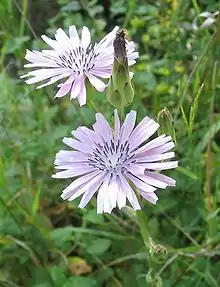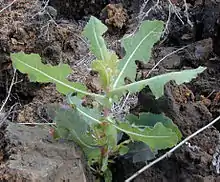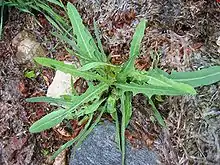Lactuca
Lactuca, commonly known as lettuce, is a genus of flowering plants in the daisy family, Asteraceae. The genus includes at least 50 species, distributed worldwide, but mainly in temperate Eurasia.
| Lettuce | |
|---|---|
 | |
| Lactuca tuberosa | |
| Scientific classification | |
| Kingdom: | Plantae |
| Clade: | Tracheophytes |
| Clade: | Angiosperms |
| Clade: | Eudicots |
| Clade: | Asterids |
| Order: | Asterales |
| Family: | Asteraceae |
| Subfamily: | Cichorioideae |
| Tribe: | Cichorieae |
| Genus: | Lactuca L. |
| Synonyms[1] | |
| |
Its best-known representative is the garden lettuce (Lactuca sativa), with its many varieties. "Wild lettuce" commonly refers to the wild-growing relatives of common garden lettuce. Many species are common weeds. Lactuca species are diverse and take a wide variety of forms. They are annuals, biennials, perennials, or shrubs.[2] Their flower heads have yellow, blue, or white ray florets. Some species are bitter-tasting.
Most wild lettuces are xerophytes, adapted to dry habitat types. Some occur in more moist areas, such as the mountains of central Africa.[2]
Diversity



There are different concepts of the species within Lactuca. It is not clear how many distinct species are known, and estimates vary from 50[1] to 75[3] so far.
- Lactuca acanthifolia (Crete, Turkey)
- Lactuca aculeata (Asia Minor)
- Lactuca acuminata
- Lactuca adenophora
- Lactuca alpestris (Crete)
- Lactuca alpina (syn. Cicerbita alpina)[6] (Europe) - alpine sow-thistle, alpine blue-sow-thistle, tall blue lettuce
- Lactuca altaica (Eurasia)
- Lactuca attenuata[7] (Africa)
- Lactuca aurea (Europe)
- Lactuca azerbaijanica (Iran)
- Lactuca biennis (North America) – tall blue lettuce, blue wood lettuce
- Lactuca calophylla (Africa)
- Lactuca canadensis (North America) – Canada wild lettuce, tall lettuce
- Lactuca corymbosa (Congo)
- Lactuca crambifolia (Turkestan)
- Lactuca cyprica (Cyprus) - Cyprus lettuce
- Lactuca deltoidea
- Lactuca dissecta (Asia)
- Lactuca dolichophylla (Asia)
- Lactuca dregeana (South Africa) – melkdissel, slaaidissel
- Lactuca dumicola
- Lactuca erostrata[8] (Pakistan)
- Lactuca fenzlii
- Lactuca floridana (North America) – Florida lettuce, woodland lettuce
- Lactuca georgica (Asia)
- Lactuca glaucifolia (Asia)
- Lactuca graciliflora (Asia)
- Lactuca graminifolia (Americas) – grassleaf lettuce
- Lactuca haimanniana
- Lactuca henryi
- Lactuca hirsuta (North America) – downy lettuce, hairy lettuce
- Lactuca hispida
- Lactuca homblei[9] (Zaire, Zambia)
- Lactuca imbricata[10] (Africa)
- Lactuca indica (Asia) - Indian lettuce
- Lactuca inermis (Africa, Arabian Peninsula)
- Lactuca intricata (Albania, Greece, Turkey)
- Lactuca jamaicensis (Jamaica)
- Lactuca kanitziana
- Lactuca kochiana
- Lactuca lasiorhiza[11] (Africa)
- Lactuca ludoviciana (North America) – biannual lettuce
- Lactuca macrophylla
- Lactuca mira
- Lactuca muralis
- Lactuca mwinilungensis[12] (Zaire, Zambia)
- Lactuca nana[13] (Africa)
- Lactuca orientalis (Asia, Egypt)
- Lactuca palmensis[14] (Canary Islands)
- Lactuca paradoxa
- Lactuca parishii
- Lactuca perennis (Europe) – blue lettuce, mountain lettuce
- Lactuca persica
- Lactuca petrensis
- Lactuca quercina (Eurasia)
- Lactuca racemosa
- Lactuca raddeana (Asia)
- Lactuca rechingeriana
- Lactuca rosularis (Iran, Turkmenistan)
- Lactuca saligna (Eurasia) – willow lettuce, least lettuce, narrow-leaf lettuce
- Lactuca sativa – lettuce, garden lettuce
- Lactuca scarioloides (western Asia)
- Lactuca schulzeana (Angola, Cameroon, Zaire)
- Lactuca schweinfurthii (Africa)
- Lactuca serriola (Africa, Asia, Europe) – prickly lettuce, compassplant, scarole, milk thistle
- Lactuca setosa (Africa)
- Lactuca sibirica (Eurasia)
- Lactuca singularis[15] (Spain)
- Lactuca songeensis
- Lactuca spinidens (Tajikistan, Turkmenistan)
- Lactuca stebbinsii[16] (Angola)
- Lactuca takhtadzhianii (Armenia)
- Lactuca tatarica (Northern Hemisphere) – blue lettuce
- Lactuca tenerrima (southern Europe, Morocco)
- Lactuca tetrantha[17] (Cyprus)
- Lactuca tinctociliata
- Lactuca triangulata (Asia)
- Lactuca triquetra
- Lactuca tuberosa (Eurasia)
- Lactuca ugandensis
- Lactuca undulata (Asia)
- Lactuca viminea (Africa, Asia, Europe) – pliant lettuce
- Lactuca virosa (Europe, northern Africa) – bitter lettuce, great lettuce
- Lactuca watsoniana[18] (Azores)
- Lactuca winkleri (Tajikistan)
Ecology
Lactuca species are used as food plants by the larvae of many Lepidoptera species.
Etymology
'Lactuca' is derived from Latin and means 'having milky sap'. 'Lactuca' and 'lactic' (of or relating to milk) have the same root word, 'lactis'.[19]
Footnotes
- Lactuca. Flora of China.
- Lebeda, Aleš; Dolezalová, Ivana; Feráková, Viera; Astley, Dave (2004). "Geographical Distribution of Wild Lactuca Species (Asteraceae, Lactuceae)". The Botanical Review. 70 (3): 328–356. doi:10.1663/0006-8101(2004)070[0328:GDOWLS]2.0.CO;2.
- Lactuca. Flora of North America.
- GRIN Species Records of Lactuca. Germplasm Resources Information Network (GRIN).
- Lactuca. The Plant List. Royal Botanic Gardens, Kew, and Missouri Botanical Garden.
- "Cicerbita alpina". Germplasm Resources Information Network (GRIN). Agricultural Research Service (ARS), United States Department of Agriculture (USDA). Retrieved 17 December 2017.
- Lactuca attenuata. Flora Zambesiaca. Royal Botanic Gardens, Kew.
- Bano, R. and M. Qaiser. (2011). A taxonomic revision of the genus Lactuca L. (Cichorieae-Asteraceae) from Pakistan and Kashmir. Pakistan Journal of Botany 43(5) 2259–268.
- Lactuca homblei. Flora Zambesiaca. Royal Botanic Gardens, Kew.
- Lactuca imbricata. Flora Zambesiaca. Royal Botanic Gardens, Kew.
- Lactuca lasiorhiza. Flora Zambesiaca. Royal Botanic Gardens, Kew.
- Lactuca mwinilungensis. Flora Zambesiaca. Royal Botanic Gardens, Kew.
- Lactuca nana. Flora Zambesiaca. Royal Botanic Gardens, Kew.
- Santos Guerra, A. 2011. Lactuca palmensis. In: IUCN 2013. IUCN Red List of Threatened Species. Version 2013.1. Downloaded on 07 July 2013.
- Draper, D. 2011. Lactuca singularis. In: IUCN 2013. IUCN Red List of Threatened Species. Version 2013.1. Downloaded on 07 July 2013.
- Kilian, N. (2001). Lactuca stebbinsii (Lactuceae, Compositae), a puzzling new species from Angola. Willdenowia - Annals of the Botanic Garden and Botanical Museum Berlin - Dahlem 31(1) 71–8.
- Kyratzis, A., et al. 2011. Lactuca tetrantha. In: IUCN 2013. IUCN Red List of Threatened Species. Version 2013.1. Downloaded on 07 July 2013.
- Schaefer, H. 2011. Lactuca watsoniana. In: IUCN 2013. IUCN Red List of Threatened Species. Version 2013.1. Downloaded on 07 July 2013.
- Gledhill, David (2008). "The Names of Plants". Cambridge University Press. ISBN 9780521866453 (hardback), ISBN 9780521685535 (paperback). pp 228

